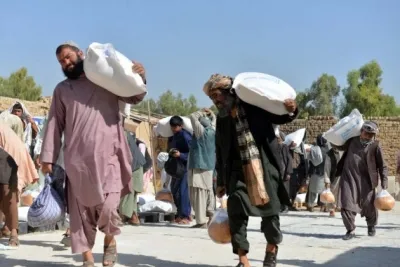Are Over Nine Million People in Afghanistan Facing Acute Food Insecurity?

Synopsis
Key Takeaways
- Over nine million Afghans face acute food insecurity.
- Severe malnutrition among children and mothers is at record levels.
- The eastern provinces of Kunar and Nangarhar are the most affected.
- Urgent funding is required to prevent catastrophic hunger.
- The ongoing crisis is worsened by lack of access to remote regions.
Kabul, Oct 2 (NationPress) The United Nations reports that over nine million individuals in Afghanistan are grappling with acute food insecurity, while escalating malnutrition is endangering both children and vulnerable families nationwide, as disclosed by local media on Thursday.
The World Food Programme (WFP) has indicated that the recent earthquake has further exacerbated an already critical food security and nutrition crisis in Afghanistan. In a report published on Thursday, the WFP revealed that more than nine million people are facing acute food insecurity, with alarming levels of severe malnutrition among children and mothers, according to Afghan news agency Khaama Press.
The report highlighted that the eastern region of Afghanistan, particularly the provinces of Kunar and Nangarhar, has been hit the hardest. These areas were already experiencing severe malnutrition prior to the earthquakes, and conditions have now deteriorated significantly.
The repatriation of Afghan nationals from Pakistan has further strained limited humanitarian resources, aggravating the situation for both displaced individuals and host communities.
To date, the WFP has delivered emergency food assistance to over 58,000 people in the provinces of Kunar, Laghman, and Nangarhar. However, the agency cautioned that numerous remote mountainous areas remain inaccessible due to challenging terrain, inadequate roads, and weak communication systems.
The agency has stated that funding shortages are critically limiting its capacity to respond. With current resources, aid can only reach fewer than one million people each month, and there is a funding gap of approximately USD 622 million for the upcoming six months. Humanitarian experts have warned that the most vulnerable groups, particularly women and children in quake-affected regions, face the risk of catastrophic hunger if urgent funding is not secured.
Last month, the WFP raised alarms about the sharp increase in hunger levels in Afghanistan and called for immediate financial support to facilitate aid delivery before winter isolates vulnerable communities across the country. On September 18, the WFP stressed the necessity of urgent funding to provide food before winter cuts off remote villages, leaving families without essential supplies.
Rania Dagash Kamara, the WFP's Deputy Executive Director, emphasized that needs remain "vast and immediate," warning that millions more Afghans could slip into extreme hunger in the coming months if new resources are not allocated.
The crisis has been aggravated by the decision of the United Nations High Commissioner for Refugees (UNHCR) to halt cash assistance programs nationwide after September 9, following restrictions imposed on female staff.









